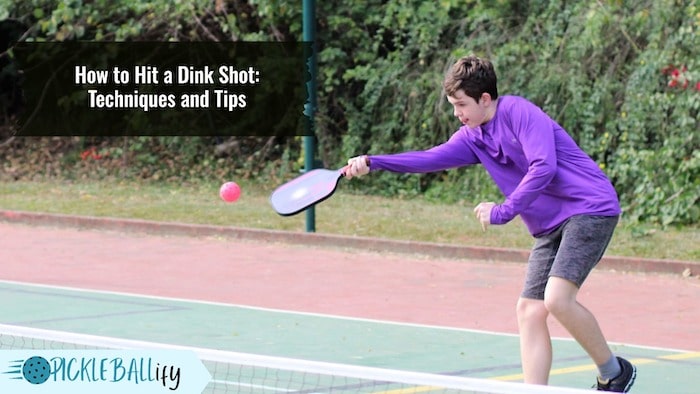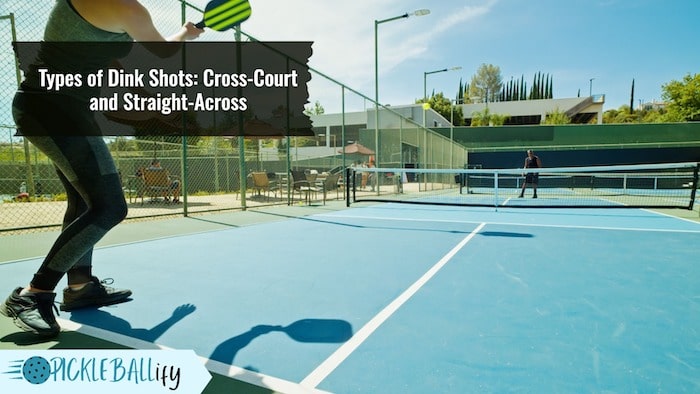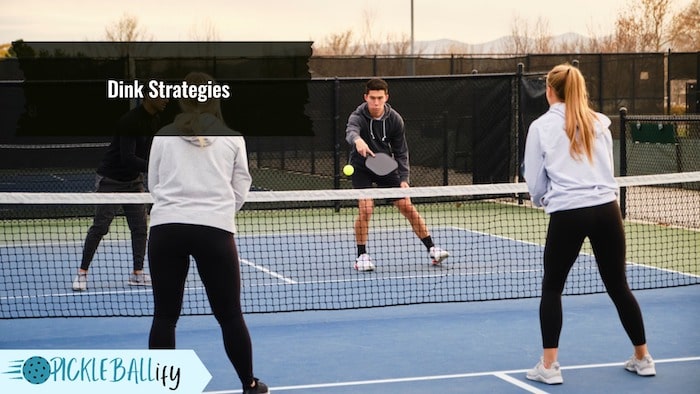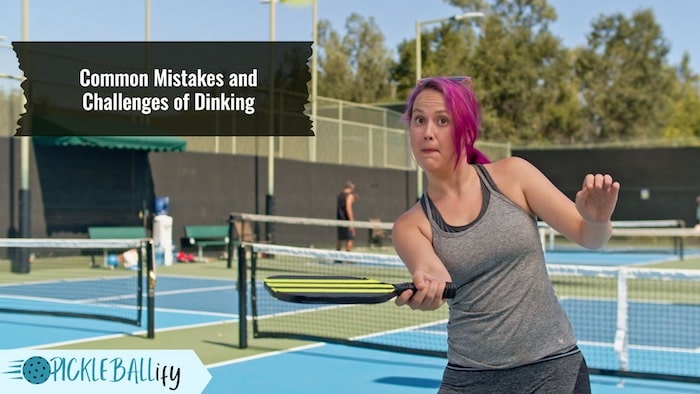Pickleball is becoming increasingly popular throughout the world, with many players seeking to master its unique set of rules and skills. One of the most important pickleball moves is the dink. If you’re new to the game or have never heard of a dink, you might be wondering what is a dink in pickleball and how it works.

We’ll go through the dink in pickleball in this article, discussing what it is, when to utilize it, and how to master the technique. Learning the dink is essential for improving your game and achieving success on the court, whether you’re a beginner or a seasoned player.
What is a Dink in Pickleball?
A dink is a controlled shot that is hit upward and lands just over the net into the opponent’s side or non-volley zone (also known as the kitchen). This technique slows down the game and forces the opponent to move out of their position.
A dink can be both offensive and defensive depending on what you want to achieve. For instance, when you want to put pressure on your opponents you play an offensive dink shot, or when you want to relieve pressure from your opponent’s strong attack then you will hit a defensive dink.
One of the main purposes of the dink shot is to hit a shot that is unattackable by your opponents. Unattackable dinks are the highest point on the arc of a shot that lands in the opponent’s kitchen. The dinks should be low so that your opponents are forced to hit the shot upward allowing you to attack, defend or get into your positions.
According to USAPickleball “An effective dink arcs downward as it crosses the net, creating a more difficult shot to return than a power shot.”
Another purpose of the dink shot is to force your opponents to play at your own pace. Dinking, otherwise known as a soft game, is a way of controlling the tempo and rhythm of the game. By hitting soft shots over the net, you can make your opponents impatient and frustrated, and induce them to make errors or give you easy balls to attack.
How to Hit a Dink Shot: Techniques and Tips
Hitting a good dink shot requires some practice and fitness. Here are some tips and techniques to help you improve your dink skills:

- Preparing Your Body: The first step is to prepare your body by going into an athletic stance with your knees bent and feet a few inches apart. This will help you balance and move quickly.
- Positioning The Paddle: The next step is to position the paddle out front of your body and keep your grip over the paddle a bit loosened. By loosening your grip, when you hit a shot you will feel control over the ball, and on contact, you can pack more power into the shot.
- Watching and Tracing Ball: Most commonly, players miss their shots because they are not paying attention or keeping an eye on pickleball. The best practice is to watch the pickleball all the way to the paddle and then hit the shot.
- Keep Moving Your Feet: Be sure to keep moving your feet when you are playing as it helps you to get into difficult positions quickly and helps you get back to your ready position back and forth. If you need to reach out for dink, be sure to take lateral steps, hit the shots, and get back to your ready position for the next shot.
- Protect Your Feet: Try not to allow the pickleball to reach your feet when you’re playing dink as it is harder to react to these shots and hitting an unstoppable shot becomes hard.
- Getting Under The Pickleball: You need to get under the ball to hit it properly. You want to lift the ball with your knees. Use an underhand stroke with a continental grip (imagine you are shaking someone’s hand as you grab the paddle). This grip is designed for hitting balls that are low or for underhand hits.
- Lifting Through The Pickleball: You want to hit a dink with a low underhand stroke. Let the ball bounce once, reach its apex, and start to fall–then hit it. You need a steady stroke to hit dinks consistently.
- Keep the Ball Over The Net: A perfect dink goes just over the net. But it is impossible to hit with such accuracy consistently. Instead, aim a good distance above the net. You don’t want to hit the ball too high or too low, as both can result in easy shots for your opponents.
A good rule of thumb is to aim for a height that is slightly above your opponent’s shoulder level.
- Be Ready After Hitting: After hitting a dink shot, you need to be ready for the next shot. Don’t assume that your dink will win the point or that your opponent will make a mistake. Always anticipate their return and be prepared to move, adjust, or attack as needed.
Types of Dink Shots: Cross-Court and Straight-Across
There are two main types of dink shots that you can use in pickleball: cross-court and straight-across. Both have their advantages and disadvantages, and you need to know when and how to use them effectively.

1) Cross-Court Dink
A cross-court dink is a shot that goes diagonally over the net and lands in the opposite corner of the opponent’s kitchen.
This type of dink has several benefits: it covers more distance, creates more angles, and it makes your opponent move more.
A cross-court dink can also set you up for an easy put-away shot if your opponent returns it weakly or pops it up.
However, a cross-court dink also has some drawbacks: It exposes more of your court, it gives your opponent more time to react. It can be intercepted by a poaching partner.
Therefore, you need to be careful when hitting a cross-court dink and make sure you have good placement, speed, and spin on the ball.
2) Straight-Across Dink
A straight-across dink is a shot that goes straight over the net and lands in the same corner of the opponent’s kitchen.
This type of dink has some advantages as well: it covers less distance, it reduces the angles, and it makes your opponent move less.
A straight-across dink can also surprise your opponent if they are expecting a cross-court shot or if they are out of position.
However, a straight-across dink also has some challenges: it requires more precision, it gives your opponent less time to react, and it can be blocked by a well-positioned partner.
Therefore, you need to be confident when hitting a straight-across dink and make sure you have good timing, control, and touch on the ball.
Dink Strategies: When and Why to Use Them
Dinking is not just a skill, but also a strategy. You need to know when and why to use dinks in different situations and against different opponents.

Here are some common scenarios where dinking can be helpful:
- When You Are at the Kitchen Line: If you are at the kitchen line and your opponent hits a low ball that bounces in front of you, you can use a dink shot to keep them at bay and prevent them from attacking. By hitting a soft shot over the net, you can maintain your position at the kitchen line and wait for an opportunity to attack or force an error from your opponent.
- When Your Opponent is at the Baseline: If your opponent is at the baseline and you have an advantage at the kitchen line, you can use a dink shot to keep them back and prevent them from advancing. By hitting a low shot that lands in their kitchen, you can make them hit an upward return that gives you an easy volley or smash.
- When Your Opponent Is Aggressive: If your opponent is aggressive and likes to hit hard shots or volleys, you can use a dink shot to slow down the game and disrupt their rhythm. By hitting soft shots over the net, you can make them impatient and frustrated, and induce them to make errors or give you easy balls to attack.
- When You Want to Change the Pace: If you want to change the pace of the game and catch your opponent off guard, you can use a dink shot to vary your shots and create unpredictability. By hitting different types of dinks (cross-court, straight-across, deep, short, long, etc.), you can keep your opponent guessing and off balance.
- When You Want to Have Fun: Dinking is not only a smart strategy, but also a fun way to play pickleball. Dinking can create long and exciting rallies that challenge your skills and endurance. Dinking can also help you bond with your partner and communicate better. Dinking can also make you appreciate the beauty and subtlety of the game.
Common Mistakes and Challenges of Dinking
Dinking is not easy to master, and it can pose some challenges and pitfalls for beginners and advanced players alike.

Here are some common mistakes and challenges of dinking and how to overcome them.
Hitting Too Hard or Too Soft
One of the most common dinking errors is striking the ball too hard or too soft. If you hit the ball excessively forcefully, your opponent will have an easy shot to attack or volley.
If you hit the ball too softly, it will either strike the net or allow your opponent to advance forward and gain control of the kitchen.
Practice striking the ball with the appropriate amount of force and touch. You want to hit the ball fast enough to clear the goal but not so fast that it travels past the kitchen.
Hitting Too High or Too Low
Another common mistake is striking the ball too high or too low. If you hit the ball too high, you risk being struck with a smash or a lob from your opponent.
If you hit the ball too low, you will either hit the net or give your opponent a low ball that they can easily dink back.
The solution is to practice striking the ball at the appropriate height and arc. You want to smash the ball high enough to clear the net, but not so high that your opponent has time to respond.
Losing Focus or Patience
One of the most difficult aspects of dining is keeping attention and patience. Dinking may be mentally exhausting and irritating, particularly if your opponent is skilled at it. You may be tempted to terminate the rally soon by hitting a hazardous shot or losing focus.
The key is to be cool and confident in your abilities and approach. Remember that dinking is a means to a goal, not an end in and of itself. You’re dinking to set up a point-winning opportunity, not to win the point with a dink.
FAQs
Yes, a dink can be hit from anywhere on the court, but it is most effective when hit from near the net or within the non-volley zone. However, it can also be used as a defensive shot from the back of the court.
No, a dink shot is not the same as a lob. A lob is a high-arcing shot that is hit over the opponent’s head, while a dink shot is a soft, controlled shot that is hit over the net and lands within the non-volley zone.
There are no specific rules regarding the dink shot in pickleball. However, players must follow the general rules of the game, such as hitting the ball within the court boundaries and avoiding touching the net or the opponent’s court.
Common mistakes include hitting the ball too hard or too high, hitting the ball too late or too early, or failing to aim the shot accurately. It’s important to practice the dink and work on your technique to avoid these mistakes.
Well, That’s a Wrap
Dinking is one of the most important and effective skills in pickleball. It can help you control the game, outsmart your opponents, and have more fun on the court. However, dinking is not easy to learn or execute, and it requires practice and finesse.
By following the tips and techniques in this article, you can improve your dink skills and become a better pickleball player.

